LAW5CNB Semester 1 2018: Consumer Law, Rights, and ACL Analysis
VerifiedAdded on 2023/06/11
|11
|3483
|131
Homework Assignment
AI Summary
This document presents a solved assignment focusing on Australian Consumer Law (ACL) issues. It addresses three questions: unfair contract terms in a gym membership agreement, exclusion clauses on receipts, and misleading representations in land advertisements. The solutions employ the IRAC method (Issue, Rule, Application, Conclusion) to analyze each scenario. It examines Megan's rights against Foxy Ladies Gym Supplies regarding unfair contract terms, Marie's rights concerning an exclusion clause and consumer guarantees, and Juliette's rights against Golden Land Pty Ltd for misleading conduct. The document concludes that the ACL provides remedies for consumers in these situations, ensuring their rights are protected against unfair terms, exclusion clauses, and misleading representations. Desklib provides access to similar solved assignments and past papers for students.
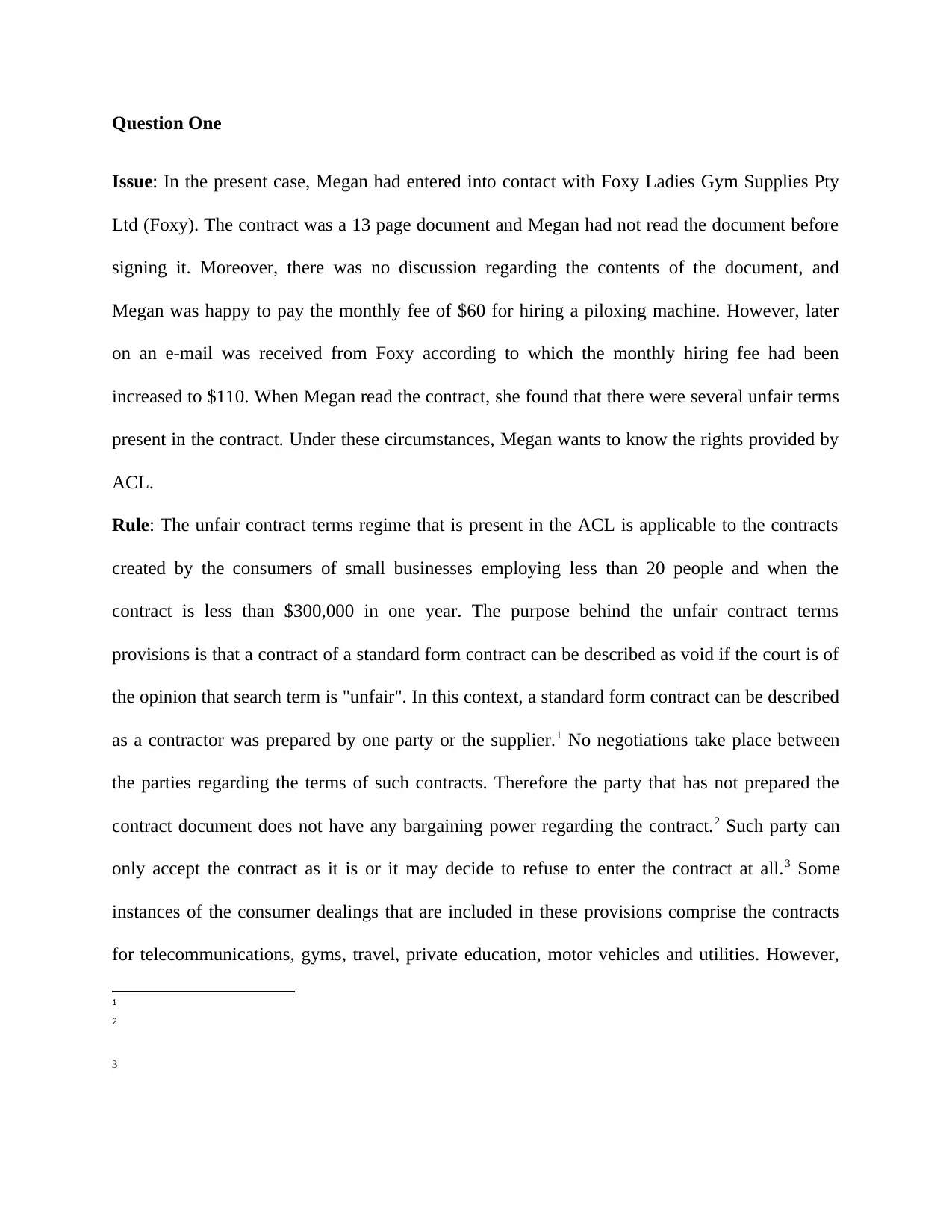
Question One
Issue: In the present case, Megan had entered into contact with Foxy Ladies Gym Supplies Pty
Ltd (Foxy). The contract was a 13 page document and Megan had not read the document before
signing it. Moreover, there was no discussion regarding the contents of the document, and
Megan was happy to pay the monthly fee of $60 for hiring a piloxing machine. However, later
on an e-mail was received from Foxy according to which the monthly hiring fee had been
increased to $110. When Megan read the contract, she found that there were several unfair terms
present in the contract. Under these circumstances, Megan wants to know the rights provided by
ACL.
Rule: The unfair contract terms regime that is present in the ACL is applicable to the contracts
created by the consumers of small businesses employing less than 20 people and when the
contract is less than $300,000 in one year. The purpose behind the unfair contract terms
provisions is that a contract of a standard form contract can be described as void if the court is of
the opinion that search term is "unfair". In this context, a standard form contract can be described
as a contractor was prepared by one party or the supplier.1 No negotiations take place between
the parties regarding the terms of such contracts. Therefore the party that has not prepared the
contract document does not have any bargaining power regarding the contract.2 Such party can
only accept the contract as it is or it may decide to refuse to enter the contract at all.3 Some
instances of the consumer dealings that are included in these provisions comprise the contracts
for telecommunications, gyms, travel, private education, motor vehicles and utilities. However,
1
2
3
Issue: In the present case, Megan had entered into contact with Foxy Ladies Gym Supplies Pty
Ltd (Foxy). The contract was a 13 page document and Megan had not read the document before
signing it. Moreover, there was no discussion regarding the contents of the document, and
Megan was happy to pay the monthly fee of $60 for hiring a piloxing machine. However, later
on an e-mail was received from Foxy according to which the monthly hiring fee had been
increased to $110. When Megan read the contract, she found that there were several unfair terms
present in the contract. Under these circumstances, Megan wants to know the rights provided by
ACL.
Rule: The unfair contract terms regime that is present in the ACL is applicable to the contracts
created by the consumers of small businesses employing less than 20 people and when the
contract is less than $300,000 in one year. The purpose behind the unfair contract terms
provisions is that a contract of a standard form contract can be described as void if the court is of
the opinion that search term is "unfair". In this context, a standard form contract can be described
as a contractor was prepared by one party or the supplier.1 No negotiations take place between
the parties regarding the terms of such contracts. Therefore the party that has not prepared the
contract document does not have any bargaining power regarding the contract.2 Such party can
only accept the contract as it is or it may decide to refuse to enter the contract at all.3 Some
instances of the consumer dealings that are included in these provisions comprise the contracts
for telecommunications, gyms, travel, private education, motor vehicles and utilities. However,
1
2
3
Secure Best Marks with AI Grader
Need help grading? Try our AI Grader for instant feedback on your assignments.
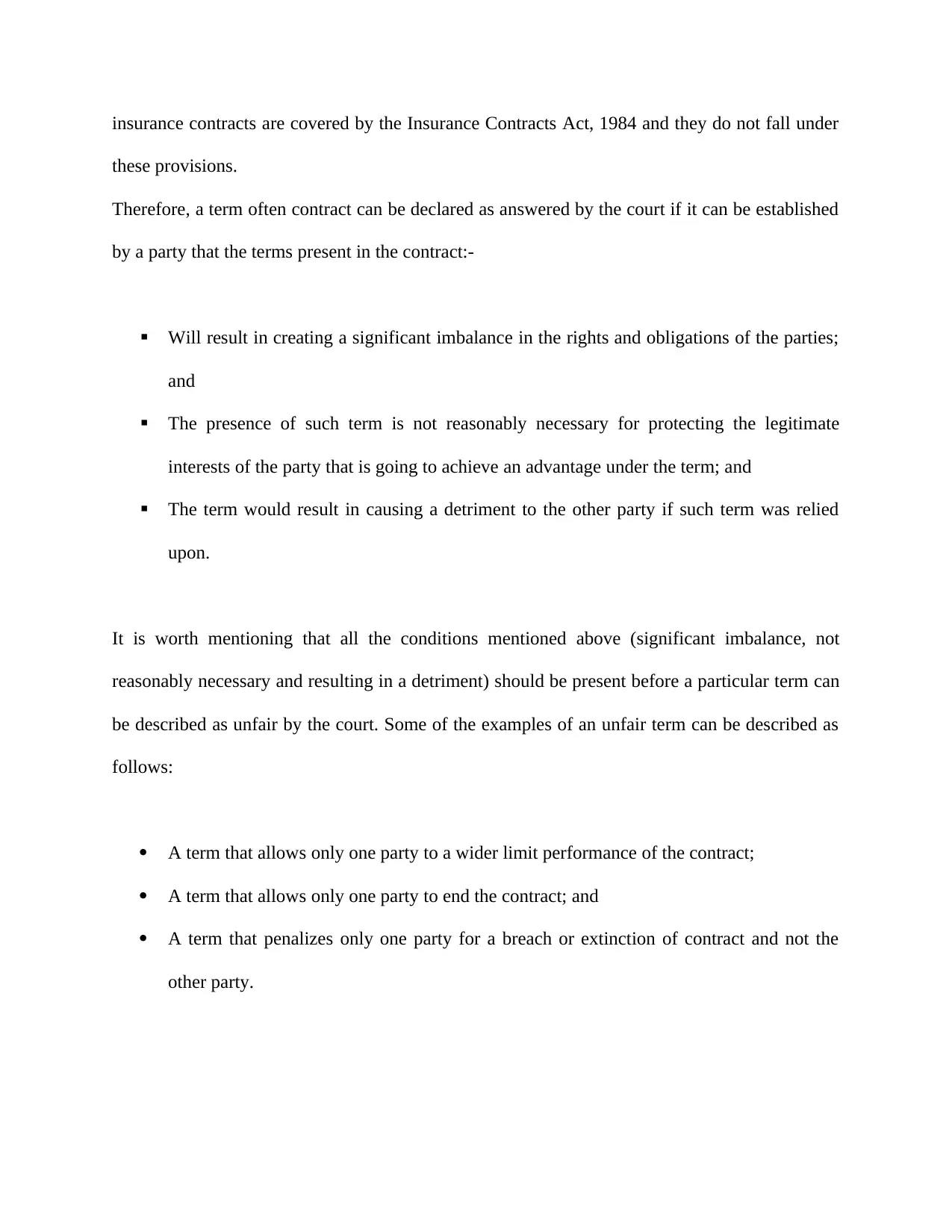
insurance contracts are covered by the Insurance Contracts Act, 1984 and they do not fall under
these provisions.
Therefore, a term often contract can be declared as answered by the court if it can be established
by a party that the terms present in the contract:-
Will result in creating a significant imbalance in the rights and obligations of the parties;
and
The presence of such term is not reasonably necessary for protecting the legitimate
interests of the party that is going to achieve an advantage under the term; and
The term would result in causing a detriment to the other party if such term was relied
upon.
It is worth mentioning that all the conditions mentioned above (significant imbalance, not
reasonably necessary and resulting in a detriment) should be present before a particular term can
be described as unfair by the court. Some of the examples of an unfair term can be described as
follows:
A term that allows only one party to a wider limit performance of the contract;
A term that allows only one party to end the contract; and
A term that penalizes only one party for a breach or extinction of contract and not the
other party.
these provisions.
Therefore, a term often contract can be declared as answered by the court if it can be established
by a party that the terms present in the contract:-
Will result in creating a significant imbalance in the rights and obligations of the parties;
and
The presence of such term is not reasonably necessary for protecting the legitimate
interests of the party that is going to achieve an advantage under the term; and
The term would result in causing a detriment to the other party if such term was relied
upon.
It is worth mentioning that all the conditions mentioned above (significant imbalance, not
reasonably necessary and resulting in a detriment) should be present before a particular term can
be described as unfair by the court. Some of the examples of an unfair term can be described as
follows:
A term that allows only one party to a wider limit performance of the contract;
A term that allows only one party to end the contract; and
A term that penalizes only one party for a breach or extinction of contract and not the
other party.
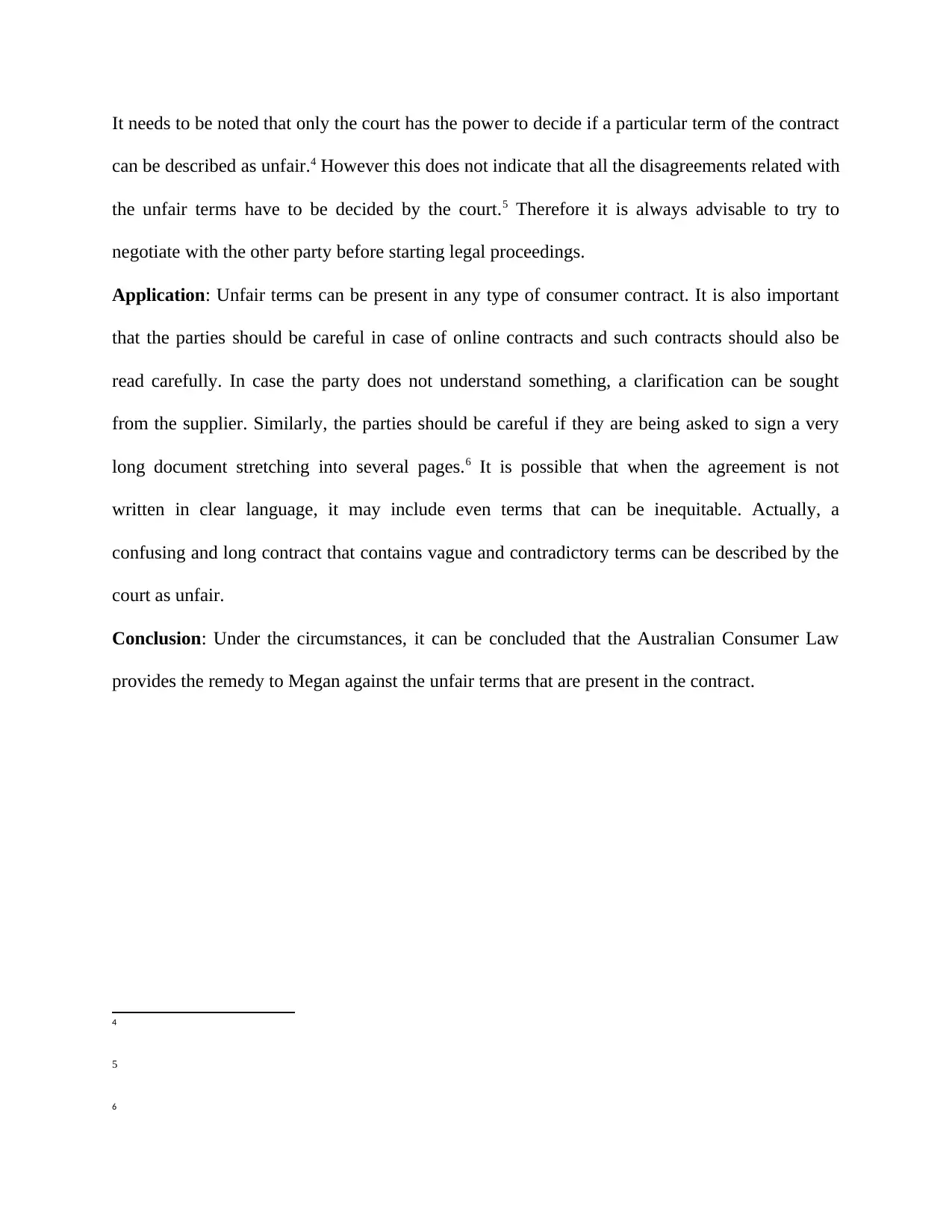
It needs to be noted that only the court has the power to decide if a particular term of the contract
can be described as unfair.4 However this does not indicate that all the disagreements related with
the unfair terms have to be decided by the court.5 Therefore it is always advisable to try to
negotiate with the other party before starting legal proceedings.
Application: Unfair terms can be present in any type of consumer contract. It is also important
that the parties should be careful in case of online contracts and such contracts should also be
read carefully. In case the party does not understand something, a clarification can be sought
from the supplier. Similarly, the parties should be careful if they are being asked to sign a very
long document stretching into several pages.6 It is possible that when the agreement is not
written in clear language, it may include even terms that can be inequitable. Actually, a
confusing and long contract that contains vague and contradictory terms can be described by the
court as unfair.
Conclusion: Under the circumstances, it can be concluded that the Australian Consumer Law
provides the remedy to Megan against the unfair terms that are present in the contract.
4
5
6
can be described as unfair.4 However this does not indicate that all the disagreements related with
the unfair terms have to be decided by the court.5 Therefore it is always advisable to try to
negotiate with the other party before starting legal proceedings.
Application: Unfair terms can be present in any type of consumer contract. It is also important
that the parties should be careful in case of online contracts and such contracts should also be
read carefully. In case the party does not understand something, a clarification can be sought
from the supplier. Similarly, the parties should be careful if they are being asked to sign a very
long document stretching into several pages.6 It is possible that when the agreement is not
written in clear language, it may include even terms that can be inequitable. Actually, a
confusing and long contract that contains vague and contradictory terms can be described by the
court as unfair.
Conclusion: Under the circumstances, it can be concluded that the Australian Consumer Law
provides the remedy to Megan against the unfair terms that are present in the contract.
4
5
6
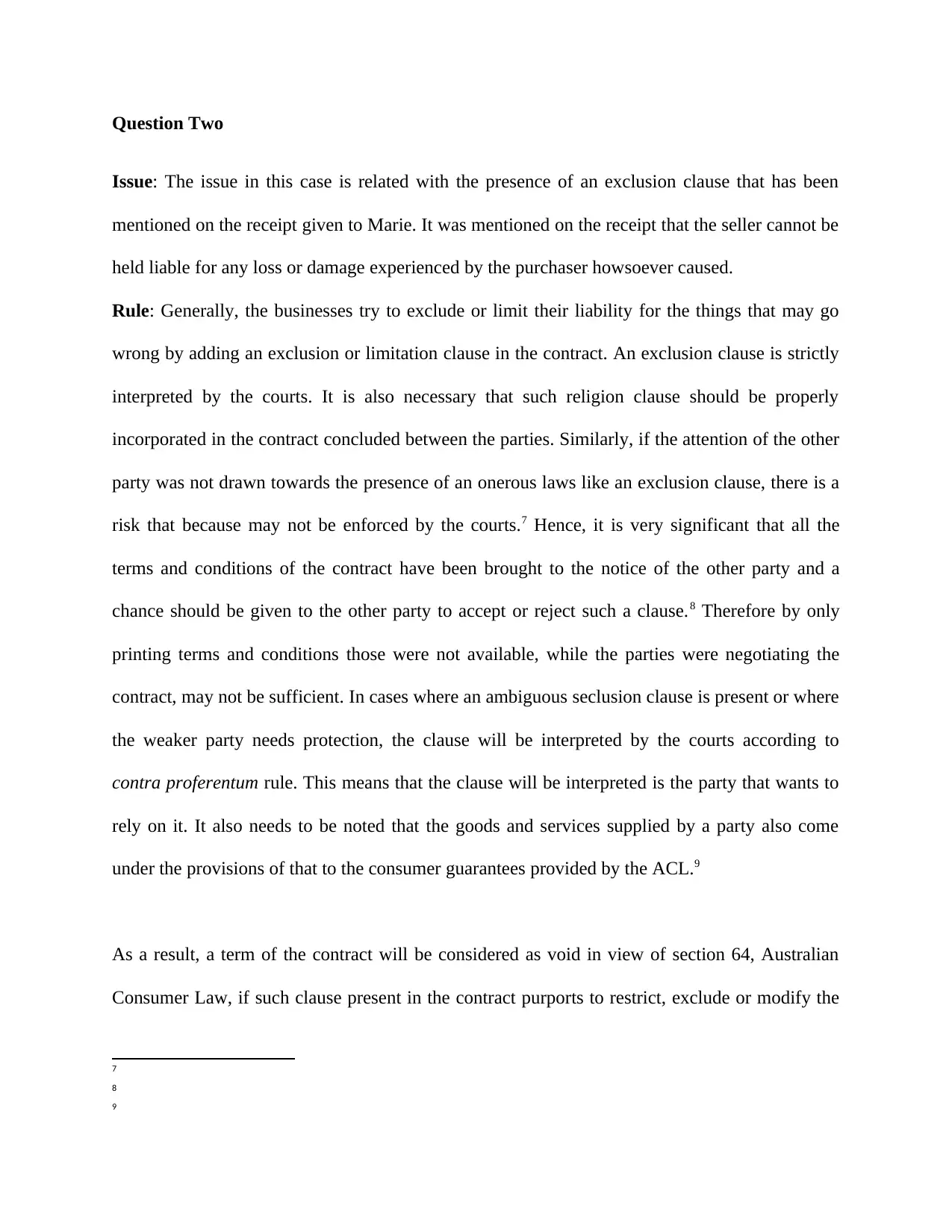
Question Two
Issue: The issue in this case is related with the presence of an exclusion clause that has been
mentioned on the receipt given to Marie. It was mentioned on the receipt that the seller cannot be
held liable for any loss or damage experienced by the purchaser howsoever caused.
Rule: Generally, the businesses try to exclude or limit their liability for the things that may go
wrong by adding an exclusion or limitation clause in the contract. An exclusion clause is strictly
interpreted by the courts. It is also necessary that such religion clause should be properly
incorporated in the contract concluded between the parties. Similarly, if the attention of the other
party was not drawn towards the presence of an onerous laws like an exclusion clause, there is a
risk that because may not be enforced by the courts.7 Hence, it is very significant that all the
terms and conditions of the contract have been brought to the notice of the other party and a
chance should be given to the other party to accept or reject such a clause.8 Therefore by only
printing terms and conditions those were not available, while the parties were negotiating the
contract, may not be sufficient. In cases where an ambiguous seclusion clause is present or where
the weaker party needs protection, the clause will be interpreted by the courts according to
contra proferentum rule. This means that the clause will be interpreted is the party that wants to
rely on it. It also needs to be noted that the goods and services supplied by a party also come
under the provisions of that to the consumer guarantees provided by the ACL.9
As a result, a term of the contract will be considered as void in view of section 64, Australian
Consumer Law, if such clause present in the contract purports to restrict, exclude or modify the
7
8
9
Issue: The issue in this case is related with the presence of an exclusion clause that has been
mentioned on the receipt given to Marie. It was mentioned on the receipt that the seller cannot be
held liable for any loss or damage experienced by the purchaser howsoever caused.
Rule: Generally, the businesses try to exclude or limit their liability for the things that may go
wrong by adding an exclusion or limitation clause in the contract. An exclusion clause is strictly
interpreted by the courts. It is also necessary that such religion clause should be properly
incorporated in the contract concluded between the parties. Similarly, if the attention of the other
party was not drawn towards the presence of an onerous laws like an exclusion clause, there is a
risk that because may not be enforced by the courts.7 Hence, it is very significant that all the
terms and conditions of the contract have been brought to the notice of the other party and a
chance should be given to the other party to accept or reject such a clause.8 Therefore by only
printing terms and conditions those were not available, while the parties were negotiating the
contract, may not be sufficient. In cases where an ambiguous seclusion clause is present or where
the weaker party needs protection, the clause will be interpreted by the courts according to
contra proferentum rule. This means that the clause will be interpreted is the party that wants to
rely on it. It also needs to be noted that the goods and services supplied by a party also come
under the provisions of that to the consumer guarantees provided by the ACL.9
As a result, a term of the contract will be considered as void in view of section 64, Australian
Consumer Law, if such clause present in the contract purports to restrict, exclude or modify the
7
8
9
Secure Best Marks with AI Grader
Need help grading? Try our AI Grader for instant feedback on your assignments.
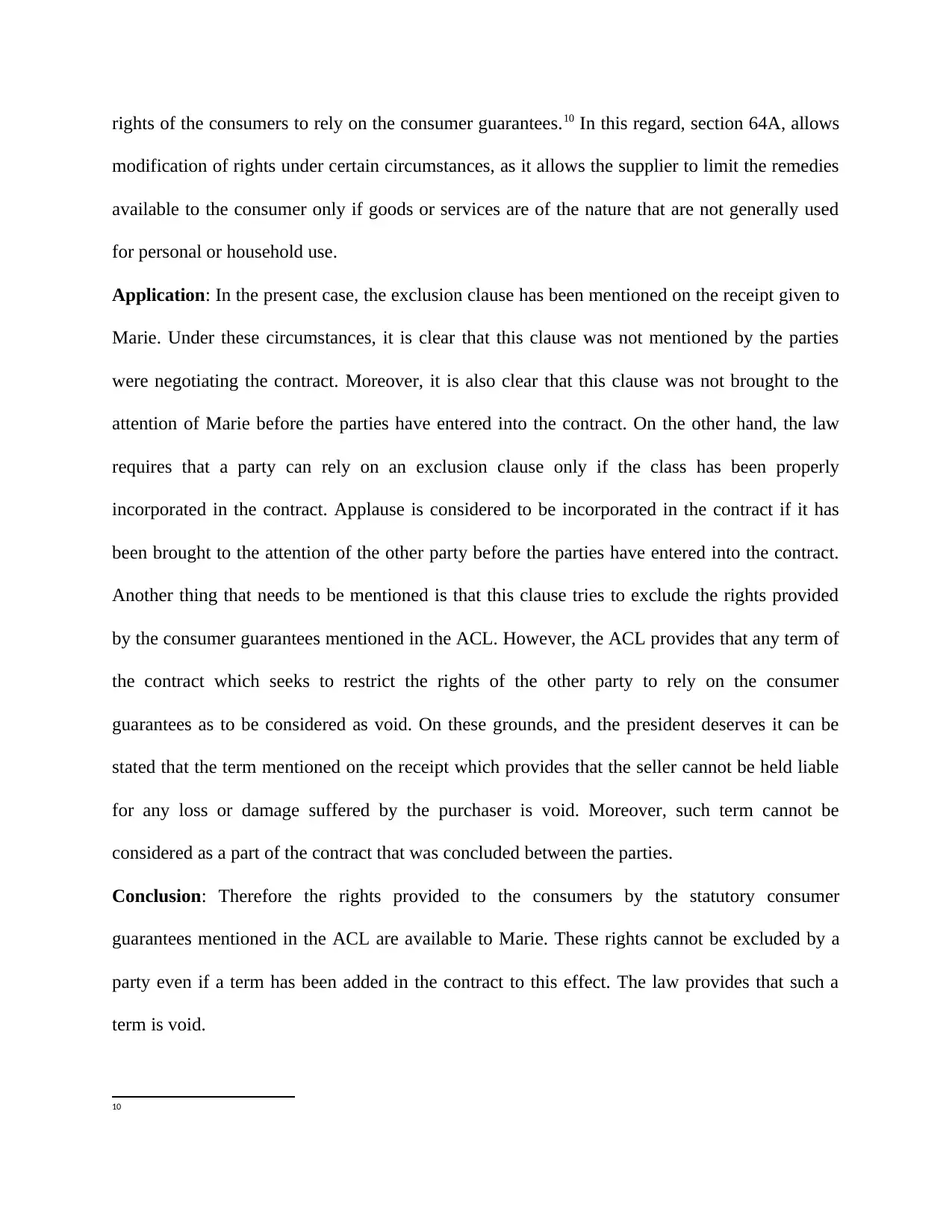
rights of the consumers to rely on the consumer guarantees.10 In this regard, section 64A, allows
modification of rights under certain circumstances, as it allows the supplier to limit the remedies
available to the consumer only if goods or services are of the nature that are not generally used
for personal or household use.
Application: In the present case, the exclusion clause has been mentioned on the receipt given to
Marie. Under these circumstances, it is clear that this clause was not mentioned by the parties
were negotiating the contract. Moreover, it is also clear that this clause was not brought to the
attention of Marie before the parties have entered into the contract. On the other hand, the law
requires that a party can rely on an exclusion clause only if the class has been properly
incorporated in the contract. Applause is considered to be incorporated in the contract if it has
been brought to the attention of the other party before the parties have entered into the contract.
Another thing that needs to be mentioned is that this clause tries to exclude the rights provided
by the consumer guarantees mentioned in the ACL. However, the ACL provides that any term of
the contract which seeks to restrict the rights of the other party to rely on the consumer
guarantees as to be considered as void. On these grounds, and the president deserves it can be
stated that the term mentioned on the receipt which provides that the seller cannot be held liable
for any loss or damage suffered by the purchaser is void. Moreover, such term cannot be
considered as a part of the contract that was concluded between the parties.
Conclusion: Therefore the rights provided to the consumers by the statutory consumer
guarantees mentioned in the ACL are available to Marie. These rights cannot be excluded by a
party even if a term has been added in the contract to this effect. The law provides that such a
term is void.
10
modification of rights under certain circumstances, as it allows the supplier to limit the remedies
available to the consumer only if goods or services are of the nature that are not generally used
for personal or household use.
Application: In the present case, the exclusion clause has been mentioned on the receipt given to
Marie. Under these circumstances, it is clear that this clause was not mentioned by the parties
were negotiating the contract. Moreover, it is also clear that this clause was not brought to the
attention of Marie before the parties have entered into the contract. On the other hand, the law
requires that a party can rely on an exclusion clause only if the class has been properly
incorporated in the contract. Applause is considered to be incorporated in the contract if it has
been brought to the attention of the other party before the parties have entered into the contract.
Another thing that needs to be mentioned is that this clause tries to exclude the rights provided
by the consumer guarantees mentioned in the ACL. However, the ACL provides that any term of
the contract which seeks to restrict the rights of the other party to rely on the consumer
guarantees as to be considered as void. On these grounds, and the president deserves it can be
stated that the term mentioned on the receipt which provides that the seller cannot be held liable
for any loss or damage suffered by the purchaser is void. Moreover, such term cannot be
considered as a part of the contract that was concluded between the parties.
Conclusion: Therefore the rights provided to the consumers by the statutory consumer
guarantees mentioned in the ACL are available to Marie. These rights cannot be excluded by a
party even if a term has been added in the contract to this effect. The law provides that such a
term is void.
10
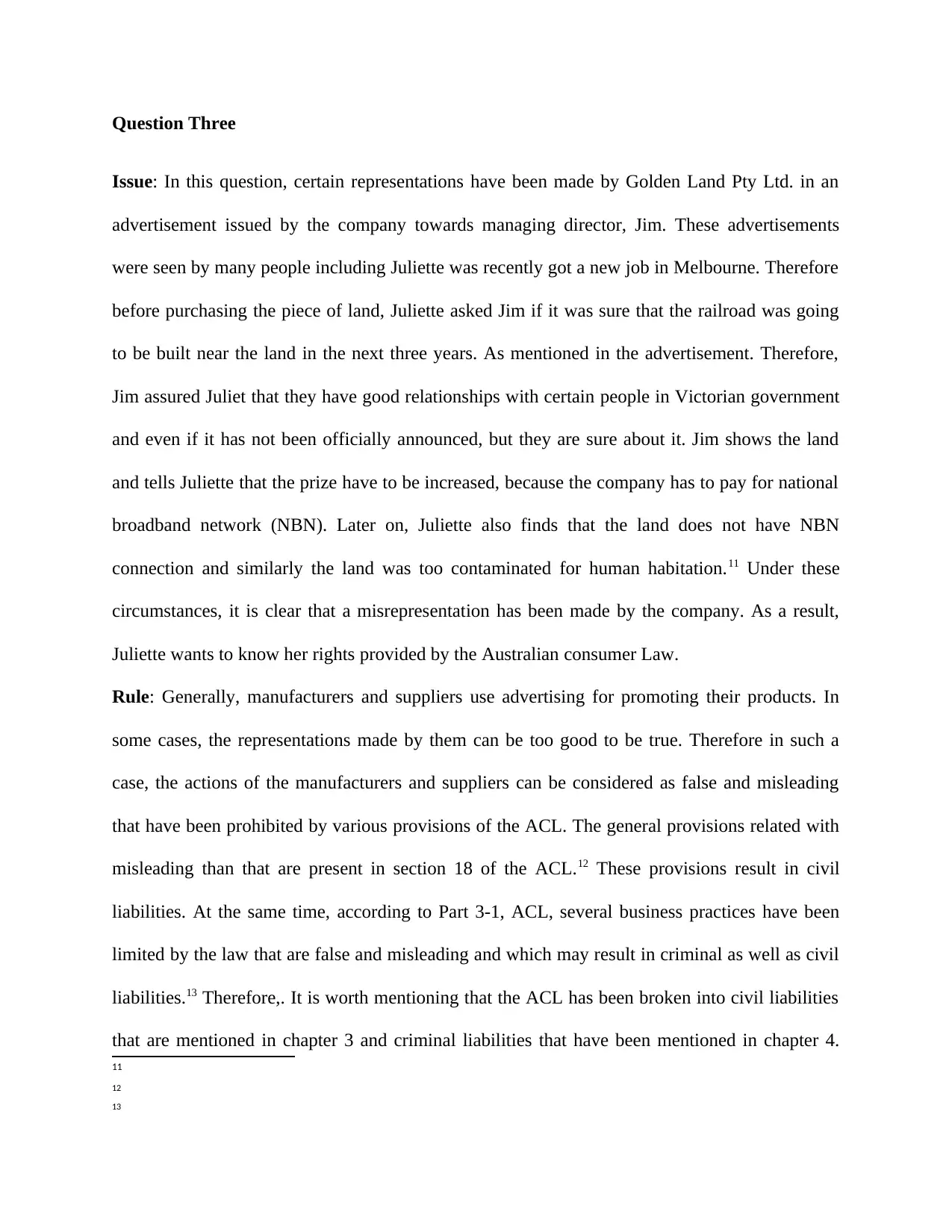
Question Three
Issue: In this question, certain representations have been made by Golden Land Pty Ltd. in an
advertisement issued by the company towards managing director, Jim. These advertisements
were seen by many people including Juliette was recently got a new job in Melbourne. Therefore
before purchasing the piece of land, Juliette asked Jim if it was sure that the railroad was going
to be built near the land in the next three years. As mentioned in the advertisement. Therefore,
Jim assured Juliet that they have good relationships with certain people in Victorian government
and even if it has not been officially announced, but they are sure about it. Jim shows the land
and tells Juliette that the prize have to be increased, because the company has to pay for national
broadband network (NBN). Later on, Juliette also finds that the land does not have NBN
connection and similarly the land was too contaminated for human habitation.11 Under these
circumstances, it is clear that a misrepresentation has been made by the company. As a result,
Juliette wants to know her rights provided by the Australian consumer Law.
Rule: Generally, manufacturers and suppliers use advertising for promoting their products. In
some cases, the representations made by them can be too good to be true. Therefore in such a
case, the actions of the manufacturers and suppliers can be considered as false and misleading
that have been prohibited by various provisions of the ACL. The general provisions related with
misleading than that are present in section 18 of the ACL.12 These provisions result in civil
liabilities. At the same time, according to Part 3-1, ACL, several business practices have been
limited by the law that are false and misleading and which may result in criminal as well as civil
liabilities.13 Therefore,. It is worth mentioning that the ACL has been broken into civil liabilities
that are mentioned in chapter 3 and criminal liabilities that have been mentioned in chapter 4.
11
12
13
Issue: In this question, certain representations have been made by Golden Land Pty Ltd. in an
advertisement issued by the company towards managing director, Jim. These advertisements
were seen by many people including Juliette was recently got a new job in Melbourne. Therefore
before purchasing the piece of land, Juliette asked Jim if it was sure that the railroad was going
to be built near the land in the next three years. As mentioned in the advertisement. Therefore,
Jim assured Juliet that they have good relationships with certain people in Victorian government
and even if it has not been officially announced, but they are sure about it. Jim shows the land
and tells Juliette that the prize have to be increased, because the company has to pay for national
broadband network (NBN). Later on, Juliette also finds that the land does not have NBN
connection and similarly the land was too contaminated for human habitation.11 Under these
circumstances, it is clear that a misrepresentation has been made by the company. As a result,
Juliette wants to know her rights provided by the Australian consumer Law.
Rule: Generally, manufacturers and suppliers use advertising for promoting their products. In
some cases, the representations made by them can be too good to be true. Therefore in such a
case, the actions of the manufacturers and suppliers can be considered as false and misleading
that have been prohibited by various provisions of the ACL. The general provisions related with
misleading than that are present in section 18 of the ACL.12 These provisions result in civil
liabilities. At the same time, according to Part 3-1, ACL, several business practices have been
limited by the law that are false and misleading and which may result in criminal as well as civil
liabilities.13 Therefore,. It is worth mentioning that the ACL has been broken into civil liabilities
that are mentioned in chapter 3 and criminal liabilities that have been mentioned in chapter 4.
11
12
13
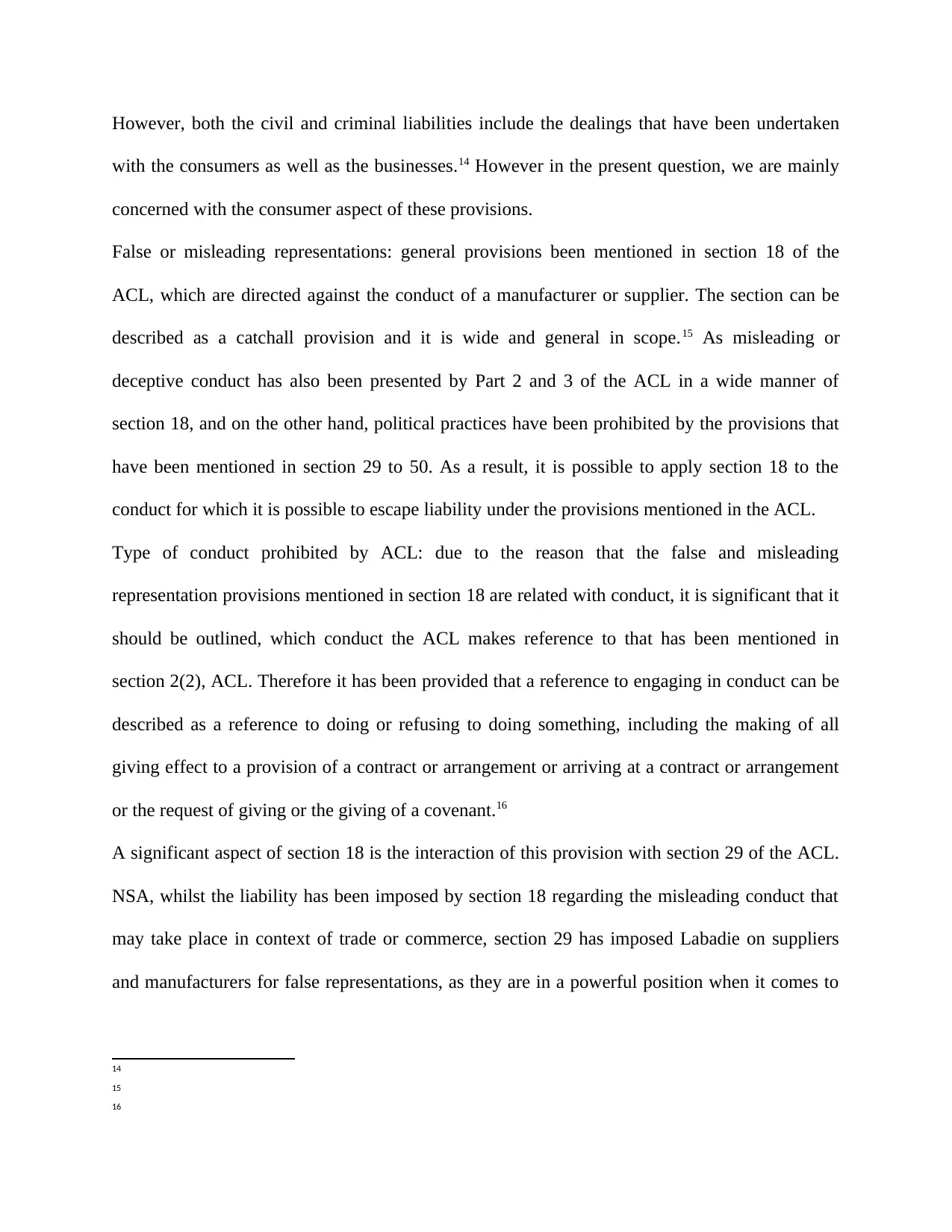
However, both the civil and criminal liabilities include the dealings that have been undertaken
with the consumers as well as the businesses.14 However in the present question, we are mainly
concerned with the consumer aspect of these provisions.
False or misleading representations: general provisions been mentioned in section 18 of the
ACL, which are directed against the conduct of a manufacturer or supplier. The section can be
described as a catchall provision and it is wide and general in scope.15 As misleading or
deceptive conduct has also been presented by Part 2 and 3 of the ACL in a wide manner of
section 18, and on the other hand, political practices have been prohibited by the provisions that
have been mentioned in section 29 to 50. As a result, it is possible to apply section 18 to the
conduct for which it is possible to escape liability under the provisions mentioned in the ACL.
Type of conduct prohibited by ACL: due to the reason that the false and misleading
representation provisions mentioned in section 18 are related with conduct, it is significant that it
should be outlined, which conduct the ACL makes reference to that has been mentioned in
section 2(2), ACL. Therefore it has been provided that a reference to engaging in conduct can be
described as a reference to doing or refusing to doing something, including the making of all
giving effect to a provision of a contract or arrangement or arriving at a contract or arrangement
or the request of giving or the giving of a covenant.16
A significant aspect of section 18 is the interaction of this provision with section 29 of the ACL.
NSA, whilst the liability has been imposed by section 18 regarding the misleading conduct that
may take place in context of trade or commerce, section 29 has imposed Labadie on suppliers
and manufacturers for false representations, as they are in a powerful position when it comes to
14
15
16
with the consumers as well as the businesses.14 However in the present question, we are mainly
concerned with the consumer aspect of these provisions.
False or misleading representations: general provisions been mentioned in section 18 of the
ACL, which are directed against the conduct of a manufacturer or supplier. The section can be
described as a catchall provision and it is wide and general in scope.15 As misleading or
deceptive conduct has also been presented by Part 2 and 3 of the ACL in a wide manner of
section 18, and on the other hand, political practices have been prohibited by the provisions that
have been mentioned in section 29 to 50. As a result, it is possible to apply section 18 to the
conduct for which it is possible to escape liability under the provisions mentioned in the ACL.
Type of conduct prohibited by ACL: due to the reason that the false and misleading
representation provisions mentioned in section 18 are related with conduct, it is significant that it
should be outlined, which conduct the ACL makes reference to that has been mentioned in
section 2(2), ACL. Therefore it has been provided that a reference to engaging in conduct can be
described as a reference to doing or refusing to doing something, including the making of all
giving effect to a provision of a contract or arrangement or arriving at a contract or arrangement
or the request of giving or the giving of a covenant.16
A significant aspect of section 18 is the interaction of this provision with section 29 of the ACL.
NSA, whilst the liability has been imposed by section 18 regarding the misleading conduct that
may take place in context of trade or commerce, section 29 has imposed Labadie on suppliers
and manufacturers for false representations, as they are in a powerful position when it comes to
14
15
16
Paraphrase This Document
Need a fresh take? Get an instant paraphrase of this document with our AI Paraphraser
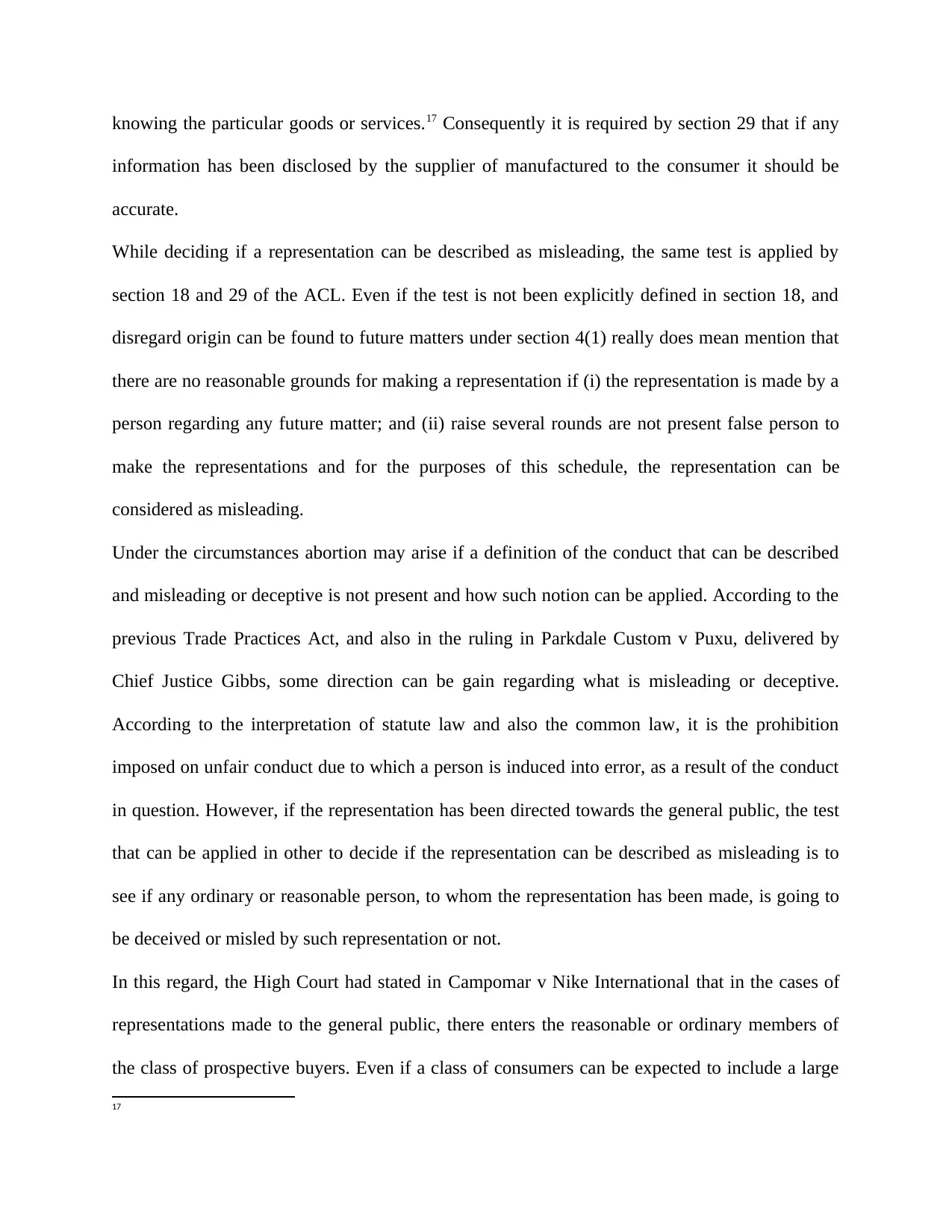
knowing the particular goods or services.17 Consequently it is required by section 29 that if any
information has been disclosed by the supplier of manufactured to the consumer it should be
accurate.
While deciding if a representation can be described as misleading, the same test is applied by
section 18 and 29 of the ACL. Even if the test is not been explicitly defined in section 18, and
disregard origin can be found to future matters under section 4(1) really does mean mention that
there are no reasonable grounds for making a representation if (i) the representation is made by a
person regarding any future matter; and (ii) raise several rounds are not present false person to
make the representations and for the purposes of this schedule, the representation can be
considered as misleading.
Under the circumstances abortion may arise if a definition of the conduct that can be described
and misleading or deceptive is not present and how such notion can be applied. According to the
previous Trade Practices Act, and also in the ruling in Parkdale Custom v Puxu, delivered by
Chief Justice Gibbs, some direction can be gain regarding what is misleading or deceptive.
According to the interpretation of statute law and also the common law, it is the prohibition
imposed on unfair conduct due to which a person is induced into error, as a result of the conduct
in question. However, if the representation has been directed towards the general public, the test
that can be applied in other to decide if the representation can be described as misleading is to
see if any ordinary or reasonable person, to whom the representation has been made, is going to
be deceived or misled by such representation or not.
In this regard, the High Court had stated in Campomar v Nike International that in the cases of
representations made to the general public, there enters the reasonable or ordinary members of
the class of prospective buyers. Even if a class of consumers can be expected to include a large
17
information has been disclosed by the supplier of manufactured to the consumer it should be
accurate.
While deciding if a representation can be described as misleading, the same test is applied by
section 18 and 29 of the ACL. Even if the test is not been explicitly defined in section 18, and
disregard origin can be found to future matters under section 4(1) really does mean mention that
there are no reasonable grounds for making a representation if (i) the representation is made by a
person regarding any future matter; and (ii) raise several rounds are not present false person to
make the representations and for the purposes of this schedule, the representation can be
considered as misleading.
Under the circumstances abortion may arise if a definition of the conduct that can be described
and misleading or deceptive is not present and how such notion can be applied. According to the
previous Trade Practices Act, and also in the ruling in Parkdale Custom v Puxu, delivered by
Chief Justice Gibbs, some direction can be gain regarding what is misleading or deceptive.
According to the interpretation of statute law and also the common law, it is the prohibition
imposed on unfair conduct due to which a person is induced into error, as a result of the conduct
in question. However, if the representation has been directed towards the general public, the test
that can be applied in other to decide if the representation can be described as misleading is to
see if any ordinary or reasonable person, to whom the representation has been made, is going to
be deceived or misled by such representation or not.
In this regard, the High Court had stated in Campomar v Nike International that in the cases of
representations made to the general public, there enters the reasonable or ordinary members of
the class of prospective buyers. Even if a class of consumers can be expected to include a large
17
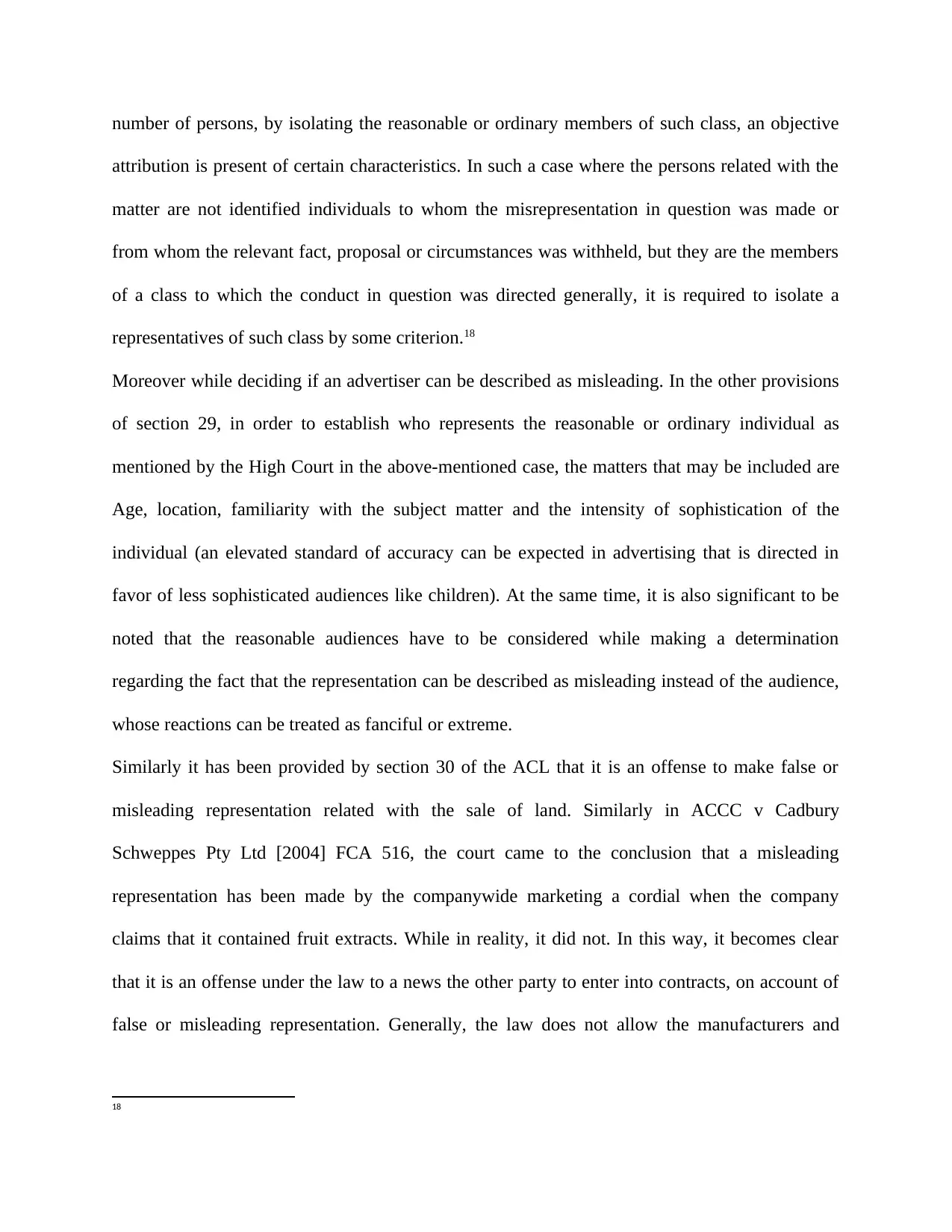
number of persons, by isolating the reasonable or ordinary members of such class, an objective
attribution is present of certain characteristics. In such a case where the persons related with the
matter are not identified individuals to whom the misrepresentation in question was made or
from whom the relevant fact, proposal or circumstances was withheld, but they are the members
of a class to which the conduct in question was directed generally, it is required to isolate a
representatives of such class by some criterion.18
Moreover while deciding if an advertiser can be described as misleading. In the other provisions
of section 29, in order to establish who represents the reasonable or ordinary individual as
mentioned by the High Court in the above-mentioned case, the matters that may be included are
Age, location, familiarity with the subject matter and the intensity of sophistication of the
individual (an elevated standard of accuracy can be expected in advertising that is directed in
favor of less sophisticated audiences like children). At the same time, it is also significant to be
noted that the reasonable audiences have to be considered while making a determination
regarding the fact that the representation can be described as misleading instead of the audience,
whose reactions can be treated as fanciful or extreme.
Similarly it has been provided by section 30 of the ACL that it is an offense to make false or
misleading representation related with the sale of land. Similarly in ACCC v Cadbury
Schweppes Pty Ltd [2004] FCA 516, the court came to the conclusion that a misleading
representation has been made by the companywide marketing a cordial when the company
claims that it contained fruit extracts. While in reality, it did not. In this way, it becomes clear
that it is an offense under the law to a news the other party to enter into contracts, on account of
false or misleading representation. Generally, the law does not allow the manufacturers and
18
attribution is present of certain characteristics. In such a case where the persons related with the
matter are not identified individuals to whom the misrepresentation in question was made or
from whom the relevant fact, proposal or circumstances was withheld, but they are the members
of a class to which the conduct in question was directed generally, it is required to isolate a
representatives of such class by some criterion.18
Moreover while deciding if an advertiser can be described as misleading. In the other provisions
of section 29, in order to establish who represents the reasonable or ordinary individual as
mentioned by the High Court in the above-mentioned case, the matters that may be included are
Age, location, familiarity with the subject matter and the intensity of sophistication of the
individual (an elevated standard of accuracy can be expected in advertising that is directed in
favor of less sophisticated audiences like children). At the same time, it is also significant to be
noted that the reasonable audiences have to be considered while making a determination
regarding the fact that the representation can be described as misleading instead of the audience,
whose reactions can be treated as fanciful or extreme.
Similarly it has been provided by section 30 of the ACL that it is an offense to make false or
misleading representation related with the sale of land. Similarly in ACCC v Cadbury
Schweppes Pty Ltd [2004] FCA 516, the court came to the conclusion that a misleading
representation has been made by the companywide marketing a cordial when the company
claims that it contained fruit extracts. While in reality, it did not. In this way, it becomes clear
that it is an offense under the law to a news the other party to enter into contracts, on account of
false or misleading representation. Generally, the law does not allow the manufacturers and
18
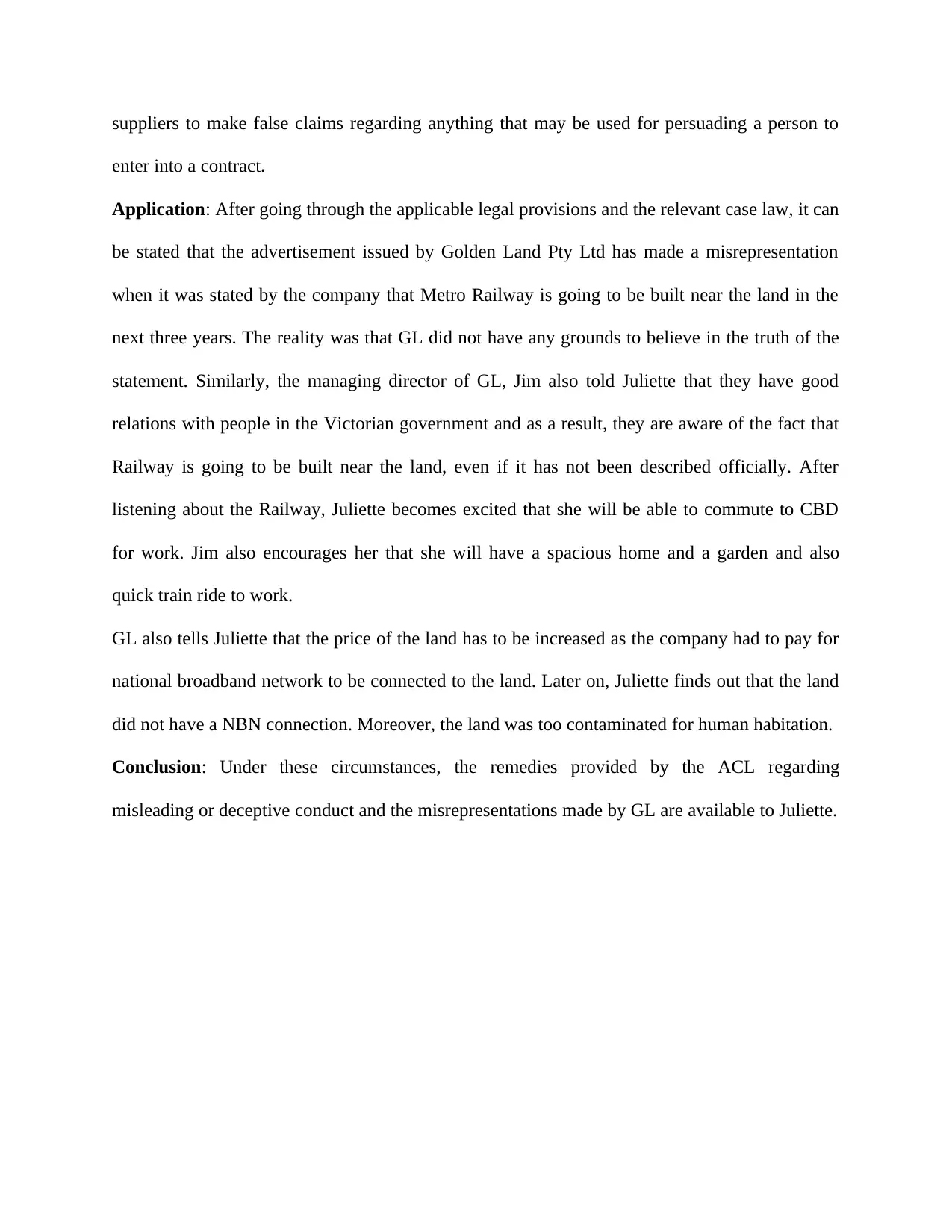
suppliers to make false claims regarding anything that may be used for persuading a person to
enter into a contract.
Application: After going through the applicable legal provisions and the relevant case law, it can
be stated that the advertisement issued by Golden Land Pty Ltd has made a misrepresentation
when it was stated by the company that Metro Railway is going to be built near the land in the
next three years. The reality was that GL did not have any grounds to believe in the truth of the
statement. Similarly, the managing director of GL, Jim also told Juliette that they have good
relations with people in the Victorian government and as a result, they are aware of the fact that
Railway is going to be built near the land, even if it has not been described officially. After
listening about the Railway, Juliette becomes excited that she will be able to commute to CBD
for work. Jim also encourages her that she will have a spacious home and a garden and also
quick train ride to work.
GL also tells Juliette that the price of the land has to be increased as the company had to pay for
national broadband network to be connected to the land. Later on, Juliette finds out that the land
did not have a NBN connection. Moreover, the land was too contaminated for human habitation.
Conclusion: Under these circumstances, the remedies provided by the ACL regarding
misleading or deceptive conduct and the misrepresentations made by GL are available to Juliette.
enter into a contract.
Application: After going through the applicable legal provisions and the relevant case law, it can
be stated that the advertisement issued by Golden Land Pty Ltd has made a misrepresentation
when it was stated by the company that Metro Railway is going to be built near the land in the
next three years. The reality was that GL did not have any grounds to believe in the truth of the
statement. Similarly, the managing director of GL, Jim also told Juliette that they have good
relations with people in the Victorian government and as a result, they are aware of the fact that
Railway is going to be built near the land, even if it has not been described officially. After
listening about the Railway, Juliette becomes excited that she will be able to commute to CBD
for work. Jim also encourages her that she will have a spacious home and a garden and also
quick train ride to work.
GL also tells Juliette that the price of the land has to be increased as the company had to pay for
national broadband network to be connected to the land. Later on, Juliette finds out that the land
did not have a NBN connection. Moreover, the land was too contaminated for human habitation.
Conclusion: Under these circumstances, the remedies provided by the ACL regarding
misleading or deceptive conduct and the misrepresentations made by GL are available to Juliette.
Secure Best Marks with AI Grader
Need help grading? Try our AI Grader for instant feedback on your assignments.
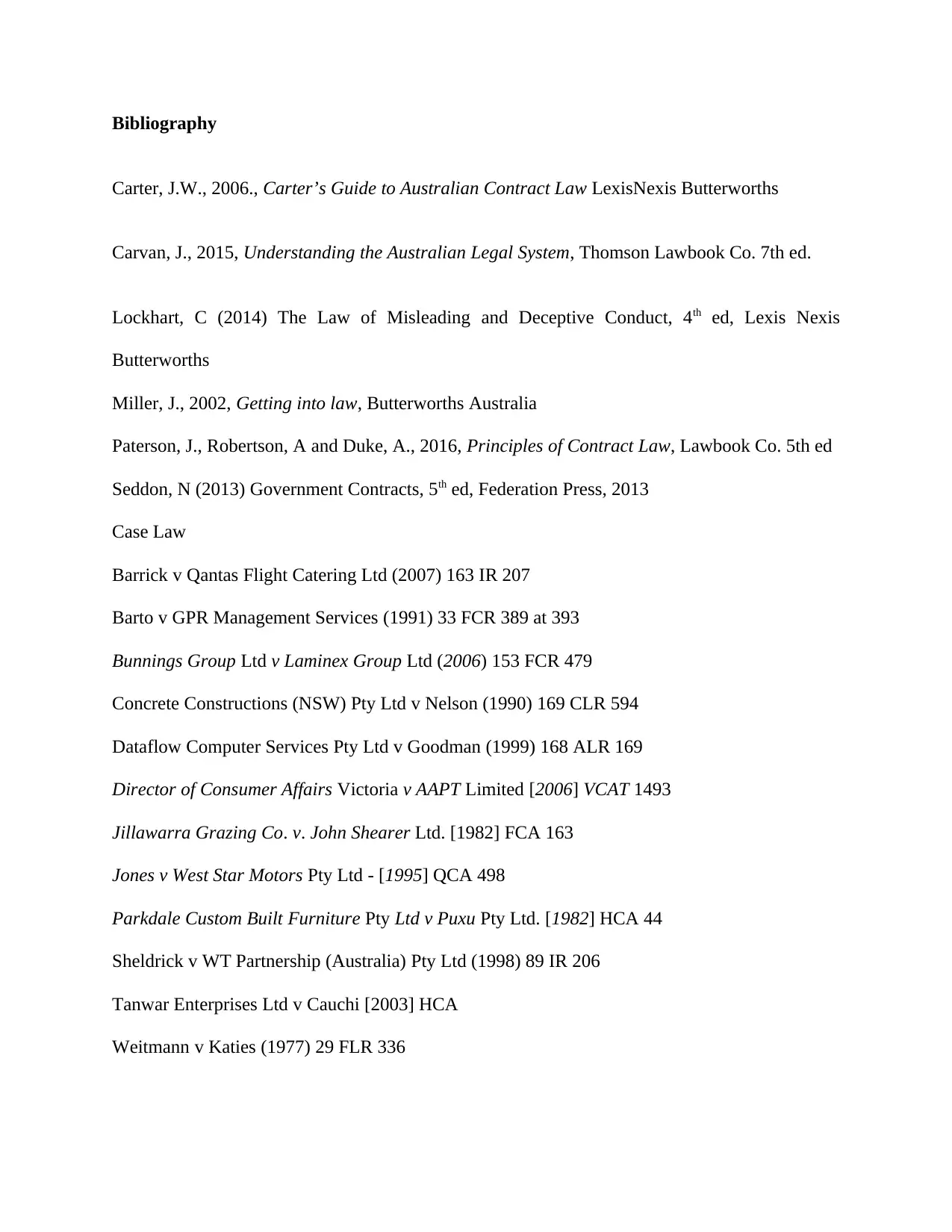
Bibliography
Carter, J.W., 2006., Carter’s Guide to Australian Contract Law LexisNexis Butterworths
Carvan, J., 2015, Understanding the Australian Legal System, Thomson Lawbook Co. 7th ed.
Lockhart, C (2014) The Law of Misleading and Deceptive Conduct, 4th ed, Lexis Nexis
Butterworths
Miller, J., 2002, Getting into law, Butterworths Australia
Paterson, J., Robertson, A and Duke, A., 2016, Principles of Contract Law, Lawbook Co. 5th ed
Seddon, N (2013) Government Contracts, 5th ed, Federation Press, 2013
Case Law
Barrick v Qantas Flight Catering Ltd (2007) 163 IR 207
Barto v GPR Management Services (1991) 33 FCR 389 at 393
Bunnings Group Ltd v Laminex Group Ltd (2006) 153 FCR 479
Concrete Constructions (NSW) Pty Ltd v Nelson (1990) 169 CLR 594
Dataflow Computer Services Pty Ltd v Goodman (1999) 168 ALR 169
Director of Consumer Affairs Victoria v AAPT Limited [2006] VCAT 1493
Jillawarra Grazing Co. v. John Shearer Ltd. [1982] FCA 163
Jones v West Star Motors Pty Ltd - [1995] QCA 498
Parkdale Custom Built Furniture Pty Ltd v Puxu Pty Ltd. [1982] HCA 44
Sheldrick v WT Partnership (Australia) Pty Ltd (1998) 89 IR 206
Tanwar Enterprises Ltd v Cauchi [2003] HCA
Weitmann v Katies (1977) 29 FLR 336
Carter, J.W., 2006., Carter’s Guide to Australian Contract Law LexisNexis Butterworths
Carvan, J., 2015, Understanding the Australian Legal System, Thomson Lawbook Co. 7th ed.
Lockhart, C (2014) The Law of Misleading and Deceptive Conduct, 4th ed, Lexis Nexis
Butterworths
Miller, J., 2002, Getting into law, Butterworths Australia
Paterson, J., Robertson, A and Duke, A., 2016, Principles of Contract Law, Lawbook Co. 5th ed
Seddon, N (2013) Government Contracts, 5th ed, Federation Press, 2013
Case Law
Barrick v Qantas Flight Catering Ltd (2007) 163 IR 207
Barto v GPR Management Services (1991) 33 FCR 389 at 393
Bunnings Group Ltd v Laminex Group Ltd (2006) 153 FCR 479
Concrete Constructions (NSW) Pty Ltd v Nelson (1990) 169 CLR 594
Dataflow Computer Services Pty Ltd v Goodman (1999) 168 ALR 169
Director of Consumer Affairs Victoria v AAPT Limited [2006] VCAT 1493
Jillawarra Grazing Co. v. John Shearer Ltd. [1982] FCA 163
Jones v West Star Motors Pty Ltd - [1995] QCA 498
Parkdale Custom Built Furniture Pty Ltd v Puxu Pty Ltd. [1982] HCA 44
Sheldrick v WT Partnership (Australia) Pty Ltd (1998) 89 IR 206
Tanwar Enterprises Ltd v Cauchi [2003] HCA
Weitmann v Katies (1977) 29 FLR 336
1 out of 11
Related Documents
Your All-in-One AI-Powered Toolkit for Academic Success.
+13062052269
info@desklib.com
Available 24*7 on WhatsApp / Email
![[object Object]](/_next/static/media/star-bottom.7253800d.svg)
Unlock your academic potential
© 2024 | Zucol Services PVT LTD | All rights reserved.





